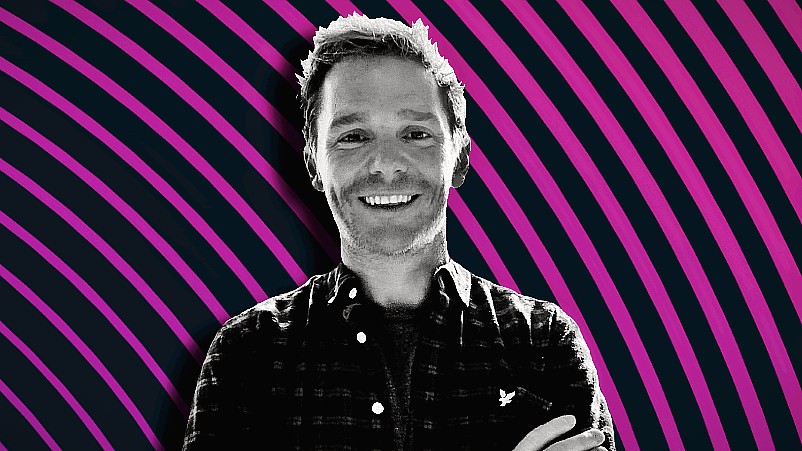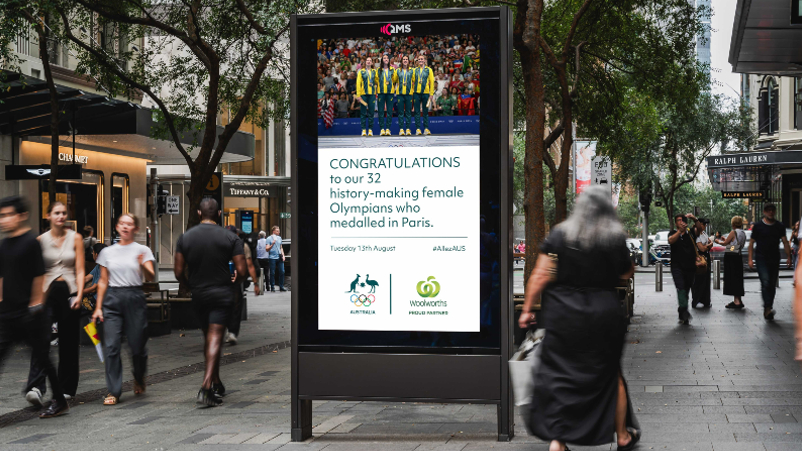‘Milk bar kids’: JCDecaux names (nearly shames) dairy sector for ignoring OOH and Gen Z’s ‘IRL bias’ in mock brief belter

Make milk great again - for GenZ. The retro return of pop-up milk mars was part of JCDecaux's snappy plan to show how OOH could help a non-OOH advertiser slow the flow of nutty milk alts to the younger set.
The cheeky peeps at JCDecaux pulled off a solid move last week to validate some serious investment into the younger set and arrest agency and advertiser bias that Gen Z is more URL than IRL (that's In Real Life for any perplexed boomers). To land the point, JCDecaux's team pulled their trump card to 300 or so agency and marketing types at Sydney's Museum of Contemporary Art. A brand facing alarming consumption problems with Gen Z - and who doesn't spend in OOH (pff) - was delivered a fully loaded strategic, creative, experiential and media schedule showing how to make its product - milk - great again and send the snappy oatmeal, soy and tumeric-infused almond nut stuff, which the kids are choosing in droves over cows milk, back to the hippies, not hipsters.
What you need to know:
- Gen Z, those aged 11-26, are ditching dairy milk for nut and oat alternatives, creating a dilemma for the dairy industry.
- JCDecaux created a mock media campaign to find and win back Zoomers.
- Research shows a combination of digital and out of home can deliver powerful results, connecting IRL (In Real Life) to URL (AKA the digital world).
- The campaign focused on using OOH, milk bar pop-ups, digital assets and GenZ messaging to arrest their misconceptions dairy milk.
- JCDecaux mapped out where Gen Z live, travel and the asset locations that would land best with .
- Creative included shareable digital billboards, pop ups and gamification, augmented by a competition to design a milkshake flavour at a Milk Bar.
- A panel of Zoomers, marketers and agency folks then explained how to best connect with Gen Z.
Call it a mock-not-mock brief: Milk consumption among Generation Z has plummeted in recent years due to a proliferation of alternative drops and ethical concerns about cow's milk, its health properties and carbon footprint.
JCDecaux spilled the milk to the dairy industry on a big fix via a clever mock media and creative strategy to flip Zoomers from their nutty consumption habits and bring them back to bovine. Although the dairy brief was fake and Holstein farmers had no heads-up – the research, data points and strategy were as engaging as the Milky Bar Kid in a rodeo.
The name-and-kinda-shame-but-not-really presentation amused the media and marketing set. A panel of Zoomer, agency and marketing types then chewed the fat over how brands should engage with Gen Z.
But first to dairy milk and its lost its mojo among Gen Z consumers.
The rise of alternative drops as well as concerns about cow milk’s health properties and climate impact, has left the younger generation 30 per cent less likely to drink dairy milk than other Australians, according to Nielsen trend data. It’s a similar story in the US, where those aged between 11 and 26 were 20 per cent less likely to drink cow’s milk in 2022.
To make matters worse, rival milk brands have been sticking the proverbial boot in, aggressively targeting Gen Z with campaigns that pander to cow’s milk concerns on the advertising platforms where – we are told – Gen Z likes to play, namely social media and out of home.
This has left the dairy industry and farmers with a dilemma: how do they win back young consumers before they kick cow’s milk into the long grass for good over trendier alts?
JCDecaux ran a mock brief using real data, insights and strategy to illustrate how out of home and digital media could deliver an engagement strategy to woo back Gen Z.
JCDecaux’s CMO Essie Wake, who assumed the role of a dairy industry marketing chief for an hour, offered a theory about the industry is struggling to connect with the elusive Gen Z crowd; a clue can be found in a recent dairy sector marketing video 35 seconds in (see below).
“If you pay careful attention you'll notice there's one glaring omission in the video – the dairy sector doesn’t use out of home advertising,” Wake quipped to a room full of media and marketing execs in Sydney last week, tongue firmly planted in cheek. “In the last 10 years, the ubiquity of alternative grain and nut-based milk has started to bite. The almond is rising and Gen Z's loyalties are very torn.”
As a faux media partner, JCDecaux set up a team to devise a campaign for the big fix: digital, out of home, gamification and experiential activations across the country were bundled into a masterplan. Key phases of the campaign included audience insight, campaign strategy, attribution and measurement.
Every purchase now comes with a perceived judgement, with a loud internal voice, about what is the ‘right choice’, turning buying milk into a complex, multi-faceted decision.
Initially, the unit worked out what makes Zoomers (FYI boomers, that’s slang for Gen Z) tick, their purchase behaviour, daily activities and thoughts about milk brands and categories.
“What we found is that what used to be a simple ubiquitous purchase at the supermarket, has now become more complex than ever before,” JCDecaux Senior Strategic Insights Specialist Anouk Kalaf said, pointing out Gen Z’s milk thought process for buying milk is a modern-day throwback to the iconic Paul’s Smarter Choice ad from 2010 (see below).
“Every purchase now comes with a perceived judgement, with a loud internal voice, about what is the ‘right choice’, turning buying milk into a complex, multi-faceted decision,” she said, as her colleague, Research and Strategy Executive John Ryan, rattled out some of the milk alternatives clouding any decision: from almond, oat, hemp, macadamia, pea, cashew to potato, hazelnut, flax and beyond.
Gen Z’s curiosity is backed up by a Pew Research Centre study that found 70 per cent of Zoomers fact check what they have read or been told, but not always from credible sources.
“As you may already know, TikTok has become somewhat of a search engine for Gen Z,” Kalaf said. “This and other social media platforms have created a hall of mirrors, a confusing world where different opinions are thrown back and forth and given equal space.”
The Gen Z paradox
Ryan said the mental gymnastics the ordinary Zoomer had to often navigate led them to challenge age-old factoids handed down through the generations, such as milk is good for them.
“Gen Z are questioning the messages that have been thrown at them from all angles, even from their own mothers!,” he said. “And our research showed that purchase decisions by Gen Z are heavily influenced by the communities that they connect with. For example - feeling like a monster drinking cow's milk when with friends who are environmentally aware.”
Interestingly, this creates a “paradox” where young individuals question everything they are told, but are ultimately swayed by groupthink.
And perceptions can be shaped by advertising that pulls on a Zoomer’s ethical heartstrings, such as the below Oatly outdoor ad presenting its set of “facts” about cow’s milk.
JCDecaux's strategy to win over Gen Z focused on the “head” – arming them with new facts that bust cow’s milk myths – and “heart” by creating emotional connections with dairy products that foster a little more brand love across Gen Z communities.
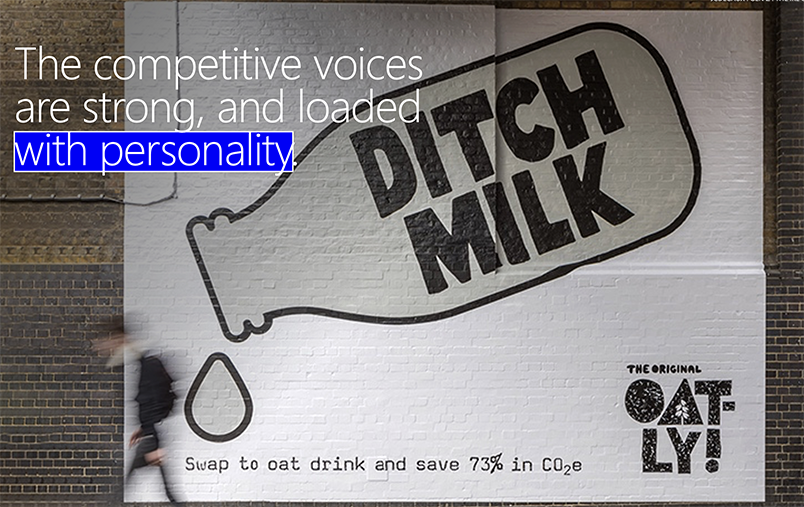
A “head” start
To educate Gen Z about Dairy Milk ‘facts’, JCDecaux deployed its proprietary Universe platform that uses a heat map to locate when Zoomers live, work and travel. It then narrows this down to a target audience segment by matching age demos with traits such as “highly influential”, “environmentally conscious” and “very social”.
A target audience heat map is overlaid with location data of JCDecaux’s outdoor assets (see below), zooming in on the panels where Zoomers are most exposed, whether it is in transit or commonly visited urban billboards.
“We created a campaign that captures the aesthetic that Gen Z craves, with the digital amplification that allows them to quiet that critical inner voice,” JCDecaux NSW Sales, Senior Account Manager Lucy Carey said (see below). “A QR code, now universal, allows for the viewer to swiftly go to a web URL that has all the facts listed and is easy to remember.
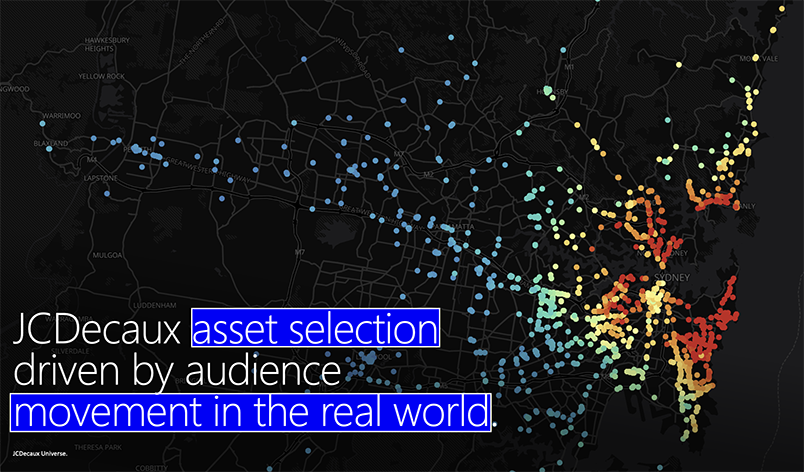
Pulling “heart” strings
Now that Zoomers were mobile cow’s milk "cyclopedias" (ALT Dairy Milk databanks), the next phase of the campaign was to tug on their heart strings with viral, shareable moments.
Lama Perin, JCDecaux’s Group Manager of Creative and Digital Solutions, said the challenge was to move down the funnel to “delight and surprise our Gen Z audience with campaign executions that drive brand love.
“We’ve recognised the challenger brands to dairy milk have already done the job of winning over the hearts of Gen Z through ‘fun’ and enticing marketing campaigns,” she explained. “Dairy Milk, dare we say it, didn’t have the cool factor that Gen Z are looking for.”
JCDecaux and Dairy Milk used out of home, dynamic digital and multi-sensory immersion activations to create “shareable, high impact experiences”.
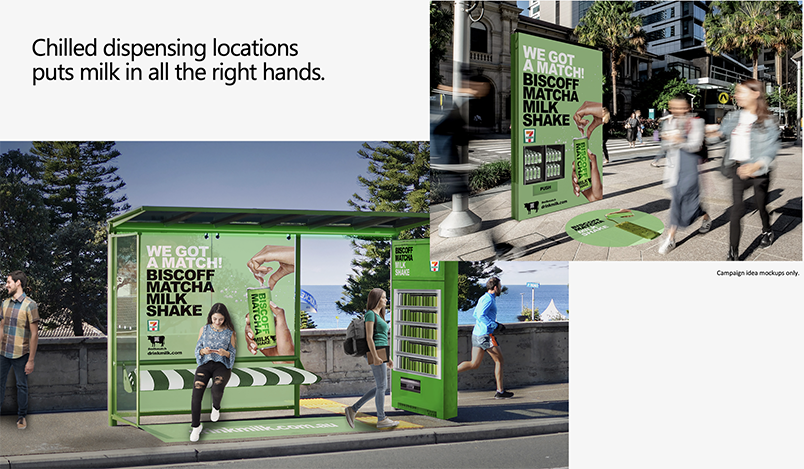
The Milk Bar kids
A highlight was a retro milk bar pop-up that allowed audiences to create custom milkshake flavours using a touch screen that was then served at the bar that could be paid for by sharing the creation on social media.
The three flavours with the highest social media engagement went into a public-vote competition, brought to life by out of home (static sites and transit), social media, and other cross-channel opportunities.
“This execution inspires curiosity with a touch of gamification that drives Gen Z audiences to tell stories from their experience, allowing the dairy industry to create that deeper connection with this audience,” Perin said.
The winning flavour, a matcha biscoff milkshake, was sold in 7 Eleven stores.
To measure upper funnel success, JCDecaux looked at website visitations using the QR code as a “connector from the IRL to the URL”, which provides data on recall and search.
Moving further down the funnel, JCDecaux carried out consumer research to track how perceptions of the dairy industry and milk were shifting among Zoomers.
Sales data from the new milkshake flavour provided conversion metrics that could be tracked geographically.
JCDecaux Senior Customer Innovation Manager Randall Taylor said it used sales data of the new milkshake to work out if Zoomers were buying more dairy milk, effectively fusing online and offline media or, as he puts it, “facilitating the future of ‘phygital’.”
IYKYK that ‘phygital’ could unlock the secret of reaching Zoomers IRL. The question is, can marketers live with the FOMO?
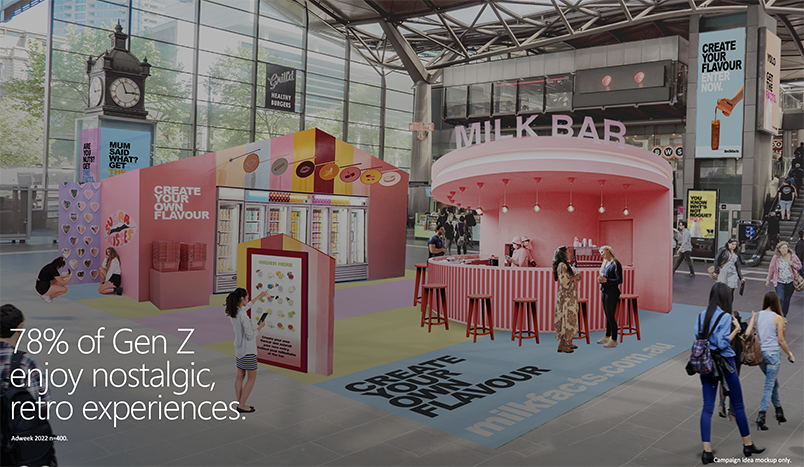
Mythbusting Gen Z: ‘We can sniff the bullshit’
Self-entitled, afraid of hard work (but wants to be promoted yesterday), woke, addicted to tech, socially awkward: these are just some of the lazy stereotypes older generations have spitballed at Generation Z since they took over the ‘young people’ baton from Millennials.
Although such descriptions may amuse curmudgeonly uncles at awkward family outings, research shows these labels are not only inaccurate, but also unhelpful, especially for brands.
That said, there are some common misconceptions about Gen Z and how brands can effectively engage with young people.
A panel of experts, including two Zoomers and Samsung’s Head of Marketing and Communications, Joanna Baxter, sought to set the record straight on how to communicate with the younger set at JCDecaux’s launch of the report Gen Z: The IRL Opportunity.
“This generation is extremely discerning and remaining relevant to them is absolutely vital,” Baxter said. “You need to build a relationship in which you are talking with them, not at them, while [being cognisant] of the challenges they are facing, such as the rising cost of living.”
Zara Seidler, a journalist, commentator co-founder of the youth publisher The Daily Aus, said collectivism and authenticity are two important values for 11 to 26 year-olds.
“This idea of authenticity shouldn’t be underestimated. Having been oversaturated with content our whole life, we can sniff bullshit in a second,” she said. “If you are trying to engage with this generation, [be honest about] your organisation and what it means to them.”
Five Gen Z tips
-
Not lazy or unmotivated: Don't conflate pursuing a work-life balance for a lack of commitment. Gen Z have lived through their parents' poor work-life balance and Covid-19 lockdowns, they prefer a new and flexible way of working.
-
Omnichannel troopers: Gen Z are not just social media addicts, they are heavy consumers of audio – particularly podcasts – gaming and TV, such as streaming.
-
IRL vs URL: Powerful campaigns that combine online and offline worlds will deliver better cut-through, especially if it garners a sense of community.
-
Challenge taboos: Gen Z will protest for what they believe in are activists and normalise topics that are societal taboos.
-
Shoot the messenger: It matters who is delivering the message as much as what the message is. This is why influencers they trust can be powerful ambassadors.
Hear out JCDecaux's Market Voice podcast with The Future Laboratory's Chris Sanderson and Martin Raymond unpacking GenZ, digital burnout and brand purpose bollocks here.

